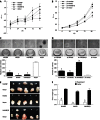MAWBP and MAWD inhibit proliferation and invasion in gastric cancer
- PMID: 23687415
- PMCID: PMC3653152
- DOI: 10.3748/wjg.v19.i18.2781
MAWBP and MAWD inhibit proliferation and invasion in gastric cancer
Abstract
Aim: To investigate role of putative mitogen-activated protein kinase activator with WD40 repeats (MAWD)/MAWD binding protein (MAWBP) in gastric cancer (GC).
Methods: MAWBP and MAWD mRNA expression level was examined by real-time reverse transcriptase-polymerase chain reaction and semi-quantitative polymerase chain reaction in six GC cell lines. Western blotting was used to examine the protein expression levels. We developed GC cells that stably overexpressed MAWBP and MAWD, and downregulated expression by RNA interference assay. Proliferation and migration of these GC cells were analyzed by 3-(4,5-dimethyl-2-thiazolyl)-2,5-diphenyl tetrazolium bromide (MTT), soft agar, tumorigenicity, migration and transwell assays. The effect of expression of MAWBP and MAWD on transforming growth factor (TGF)-β1-induced epithelial-mesenchymal transition (EMT) was examined by transfection of MAWBP and MAWD into GC cells. We detected the levels of EMT markers E-cadherin, N-cadherin and Snail in GC cells overexpressing MAWBP and MAWD by Western blotting. The effect of MAWBP and MAWD on TGF-β signal was detected by analysis of phosphorylation level and nuclear translocation of Smad3 using Western blotting and immunofluorescence.
Results: Among the GC cell lines, expression of endogenous MAWBP and MAWD was lowest in SGC7901 cells and highest in BGC823 cells. MAWBP and MAWD were stably overexpressed in SGC7901 cells and knocked down in BGC823 cells. MAWBP and MAWD inhibited GC cell proliferation in vitro and in vivo. MTT assay showed that overexpression of MAWBP and MAWD suppressed growth of SGC7901 cells (P < 0.001), while knockdown of these genes promoted growth of BGC823 cells (P < 0.001). Soft agar colony formation experiments showed that overexpression of MAWBP and MAWD alone or together reduced colony formation compared with vector group in SGC7901 (86.25 ± 8.43, 12.75 ± 4.49, 30 ± 6.41 vs 336.75 ± 22.55, P < 0.001), and knocked-down MAWBP and MAWD demonstrated opposite effects (131.25 ± 16.54, 88.75 ± 11.12, 341.75 ± 22.23 vs 30.25 ± 8.07, P < 0.001). Tumorigenicity experiments revealed that overexpressed MAWBP and MAWD inhibited GC cell proliferation in vivo (P < 0.001). MAWBP and MAWD also inhibited GC cell invasion. Transwell assay showed that the number of traverse cells of MAWBP, MAWD and coexpression group were more than that in vector group (84 ± 16.57, 98.33 ± 9.8, 29 ± 16.39 vs 298 ± 11.86, P < 0.001). Coexpression of MAWBP and MAWD significantly decreased the cells traversing the matrix membrane. Conversely, knocked-down MAWBP and MAWD correspondingly promoted invasion of GC cells (100.67 ± 14.57, 72.66 ± 8.51, 330.67 ± 20.55 vs 27 ± 11.53, P < 0.001). More importantly, coexpression of MAWBP and MAWD promoted EMT. Cells that coexpressed MAWBP and MAWD displayed a pebble-like shape and tight cell-cell adhesion, while vector cells showed a classical mesenchymal phenotype. Western blotting showed that expression of E-cadherin was increased, and expression of N-cadherin and Snail was decreased when cells coexpressed MAWBP and MAWD and were treated with TGF-β1. Nuclear translocation of p-Smad3 was reduced by attenuating its phosphorylation.
Conclusion: Coexpression of MAWBP and MAWD inhibited EMT, and EMT-aided malignant cell progression was suppressed.
Keywords: Epithelial-mesenchymal transition; Gastric cancer; Invasion; Mitogen-activated protein kinase activator with WD40 repeats; Mitogen-activated protein kinase activator with WD40 repeats binding protein; Transforming growth factor-β.
Figures






References
-
- Parkin DM, Bray F, Ferlay J, Pisani P. Global cancer statistics, 2002. CA Cancer J Clin. 2005;55:74–108. - PubMed
-
- Becker K, Langer R, Reim D, Novotny A, Meyer zum Buschenfelde C, Engel J, Friess H, Hofler H. Significance of histopathological tumor regression after neoadjuvant chemotherapy in gastric adenocarcinomas: a summary of 480 cases. Ann Surg. 2011;253:934–939. - PubMed
-
- Hass HG, Smith U, Jäger C, Schäffer M, Wellhäuber U, Hehr T, Markmann HU, Nehls O, Denzlinger C. Signet ring cell carcinoma of the stomach is significantly associated with poor prognosis and diffuse gastric cancer (Lauren’s): single-center experience of 160 cases. Onkologie. 2011;34:682–686. - PubMed
-
- Leal MF, Calcagno DQ, Borges da Costa Jde F, Silva TC, Khayat AS, Chen ES, Assumpção PP, de Arruda Cardoso Smith M, Burbano RR. MYC, TP53, and chromosome 17 copy-number alterations in multiple gastric cancer cell lines and in their parental primary tumors. J Biomed Biotechnol. 2011;2011:631268. - PMC - PubMed
Publication types
MeSH terms
Substances
LinkOut - more resources
Full Text Sources
Other Literature Sources
Medical
Molecular Biology Databases
Research Materials
Miscellaneous

